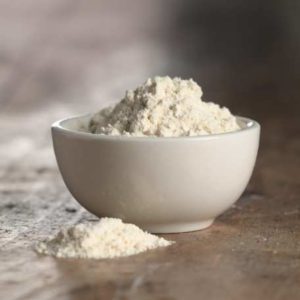Wheat Gluten, also called seitan (Japanese: セイタン), wheat meat, gluten meat, or simply gluten, is a food made from gluten, the main protein of wheat. It is made by washing wheat flour dough with water until all the starch granules have been removed, leaving the sticky insoluble gluten as an elastic mass which is then cooked before being eaten.
Uses
- Wheat gluten is an alternative to soybean-based foods such as tofu, which are sometimes used as meat substitutes. Some types of wheat gluten have a chewy or stringy texture that resembles meat more than other substitutes. Wheat gluten is often used instead of meat in Asian, vegetarian, Buddhist, and macrobiotic cuisines. Mock duck is a common use for wheat gluten.
Benefits
-
Packed With Protein
Vital wheat gluten is extremely high in protein, and because of this, it is a healthy alternative to animal protein sources. The U.S. Department of Agriculture recommends that you include a variety of proteins in your diet, including ones from vegetable sources, which include gluten. A 50-gram serving of vital wheat gluten mixed with water or broth produces 2 ounces of seitan or gluten in a solid form, which has almost 38 grams of protein per serving. This is 68 to 83 percent of the recommended dietary allowance of grams of protein for men and women, respectively.
-
Rich in Phosphorous
A 2-ounce serving of wheat gluten has 130 milligrams of phosphorous. This is 19 percent of the recommended dietary intake of this essential mineral for adults. Phosphorous makes up 1 percent of your total body weight and is stored primarily in your bones and teeth. It helps your body process and make use of carbohydrates and fats, as well as the production of protein for healthy development. It aids in the repair, maintenance and growth of all cells and tissues.
Significant Source of Microminerals
Vital wheat gluten is a significant source of the minerals iron and selenium. A 2-ounce serving has 2.6 milligrams of iron. This is 14 percent of the recommended daily intake for adult women, and 32 percent for adult men and women over 50 years of age. Iron is considered essential for your overall health because it aids in the production of red blood cells, namely hemoglobin and myoglobin, which carry oxygen throughout your body. A 2-ounce serving of vital wheat gluten also contains 19.8 micrograms of selenium, an essential trace mineral. The recommended dietary allowance of selenium is 55 micrograms per day for adults, with a serving of vital wheat gluten providing 36 percent of the RDA. Selenium is important in DNA production and for making thyroid hormones.
Low in Fat And Promotes Ideal Weight
Vital wheat gluten is a naturally low-fat protein source, with less than 1 gram of fat per 2-ounce serving and no cholesterol. Eating a diet low in fat can help you keep your cholesterol levels in check — something that can be a problem if you regularly eat proteins high in saturated fats, such as bacon or fatty cuts of beef — and potentially help reduce your risk of heart disease. A 2004 issue of the “Journal of Nutrition” found that eating a high-protein, low-fat diet, of which wheat gluten can be a part of, increased both the likelihood of weight loss and satisfaction with the diet in healthy adults.
Cautions
- Gluten City: So again, seitan is the gluten component of wheat. It’s purely gluten. So for anyone who has celiac disease, a gluten sensitivity or is just generally looking to reduce the amount of gluten in his or her diet, this is not a food you want to eat.
- Not a Complete ProteinSeitan and lean meat may have similar amounts of protein, but they’re by no means equatable. Seitan does not contain all of the essential amino acids while meat contains all of the essential amino acids that our bodies need to function. Seitan might be a protein food, but it cannot be classified as a complete protein.
- Allergy Promoting? Seitan recently made a recent list of “7 Foods a Nutritionist Would Never Eat.” Many health experts stay away from seitan because, like me, they really don’t believe it to be a healthy form of protein. Wheat gluten is a highly allergenic protein. When you consume most wheat-centric products, like wheat bread, there is naturally going to be a small amount of wheat gluten present.
- High Sodium Content Most people who eat seitan probably don’t make it at home. They most likely eat it at restaurants or buy it pre-made at the store. This seitan is almost definitely an ultra-processed food. These highly processed versions are typically hazardously high in sodium, which can contribute to high blood pressure and a host of other health problems.
Interactions
n/a
Other names
- seitan
References
Source: Wikipedia, https://en.wikipedia.org/wiki/Wheat_gluten_(food)
LiveStrong, http://www.livestrong.com/article/272460-health-benefits-of-vital-wheat-gluten/

